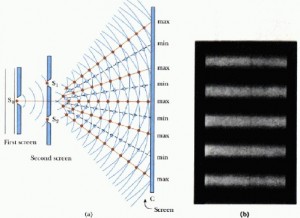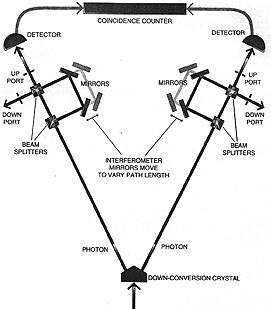Physicist: Yuppers.
The classic example is Young’s Double Slit experiment.

a) Experimental set up for Young's Double Slit experiment. b) The astounding results. Image stolen from here.
When coherent light is shined on two slits, then the image that’s projected on the final screen exhibits interference patterns (because light is a wave, of course). Back in the day, Mr. T. Young got his coherent light by only allowing light to come through a single tiny hole, thus preventing any interference from other sources (as in light from the left side of a window interfering with light from the right side of a window). It was very dark and, I suspect, lonely. These days we have kick-ass lasers, well lit labs, and occasionally married scientists.
Einstein demonstrated that photons are particles (of course) with the “photo-electric effect”. Now, here’s what makes Young’s experiment such an excellent argument for why the universe hates scientists: The interference fringes continue to persist no matter how much you turn down the intensity of the light source. Even when the source is so low that only one photon is being released at time, you can still see interference. The conclusion is that a single photon can interfere with itself.
WTF! you may say. And rightly so. If it goes through the lower slit, then obviously it didn’t go through the upper slit, so obviously it shouldn’t have any idea that the upper slit is even there, and visa versa. However, the pattern on the screen is exactly consistent with the (single) photon acting like a wave: interfering with itself, being in many places, and all that.
Here’s something even worse: A particle can actually interfere with itself across time as well. In the double slit experiment the photon self-interferes between two uncertain sources in space (which slit did the photon go through?). Experiments, such as the “Franson Experiment”, have been done to demonstrate self-interference where the source of light is uncertain in time (when was the photon emitted?). The exact details of the experiment are subtle and surprisingly boring, so just go with it.

Set up for the Franson Experiment
As an aside, the Franson experiment also shows that not only do things have multiple futures (Young: the photon will go through both slits), but also that things have multiple pasts (Franson: the photon you observe was emitted at several different times). Please send all complaints to: The Universe, et al.







Pingback: Q: Do physicists really believe in true randomness? « Ask a Mathematician / Ask a Physicist
Pingback: KADAGAYA PROJECT: PART THREE | baby grand